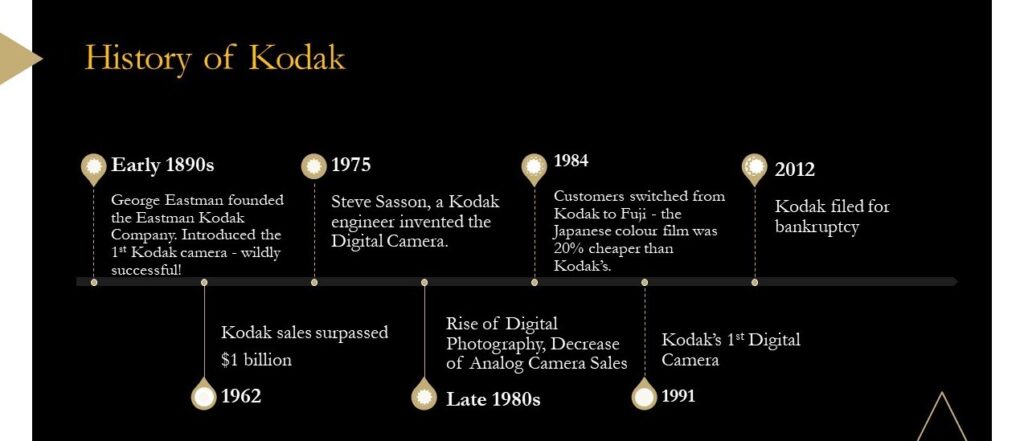Remember walking past Kodak studios during your childhood? I do! Do you?
Okay if not, we often map it to those pretty (vintage?) cameras, isn’t it? Yes, it’s the Kodak we’ve known all these years.
For almost a hundred years, Kodak has led the photograph business with its innovations. But then why did it fail, being a pioneer in this industry? Is it because it didn’t make a huge push into digital, i.e saw risks of cannibalizing its strong core business?
George Eastman founded the ‘The Eastman Kodak Company’ in 1888. In the 20th century, Kodak was the go-to name when it comes to the world of photography and videography.

It indeed brought about a revolution in the filming industry! At a time when cameras were only available at big companies for recording movies, Kodak enabled the use of cameras in every household by producing cameras that were portable and affordable. Until the 1990s it was regularly rated one of the world’s five most valuable brands.
In the 1980s, the photography industry was beginning to shift towards the digital. A Kodak engineer, Steve Sasson by name, invented the 1st ever digital camera, in 1975! Kodak’s action towards the digital world seemed to be the most logical step.
Deeper Insights On Kodak’s Business Model
Kodak adopted the ‘razor and blade’ business model. Kodak sold cameras at much affordable prices with only a small profit margin and then sold the consumable supplies such as films, printing sheets, and other accessories with high-profit margins.
This model refers to the idea that consumers buying razors, will buy blades in a recurring manner. Kodak did benefit from having adopted this model and made huge amounts of revenue.

What did the core business revolve around? The clients would take photos with the Kodak camera and then send it to the Kodak factory where the camera’s film was developed, and photos were printed.
The company’s core product was the film and printing photos, not the camera.
Why could Kodak never become a major player in the evolving industry?
Kodak’s management failed to understand the disruption and ended up becoming a victim to the aftershocks of a disruptive change. Kodak makes a great case for cognitive biases that led the management to take irrational decisions.
Kodak created a digital camera and invested in technology. It even understood that photos would be shared online. The company did, in fact, pursue the digital photography business in a serious way.
In fact, its EasyShare line of cameras were top sellers. It also made big investments in quality printing for digital photos. Long before social media and digital media was popularized, Kodak made a purchase, acquiring a photo-sharing site called Ofoto in 2001. Instead of making Ofoto a pioneer of a new category where people could share pictures, Kodak used Ofoto to try to get more people to print digital images.
Read on to know what led Kodak to declare itself bankrupt in 2012!
Once one of the most powerful companies in the world, today the company has a market capitalization of less than $100Mn. More than 145,000 jobs were lost.

Here’s What Kodak Didn’t Do: It Didn’t Have A Careful Yet Holistic Take!
The management team at Kodak did a commendable job at realizing and thus tapping the full potential of the diverse teams of the enterprise – understanding how they interacted within the architecture of the existing technology then.
However, the research at the Kodak Research Laboratory on digital technology wasn’t appreciated as much. Executives also feared cannibalizing their core film sales and didn’t gear up to make revolutionary changes – although going digital was proving to become the trend then.
Lesson learnt – Adopt agility as an organisational strategy for development.
More than 90% of agile respondents say that their leaders provide actionable strategic guidance; that they have established a shared vision and purpose; and that people in their unit are entrepreneurial (in other words, they proactively identify and pursue opportunities to develop in their daily work)
The concept of organizational agility is catching fire as companies scurry to deal with rapid change and complexity.’
~McKinsey&Co 2017
Kodak Failed To Listen To The End Customers
As digital imaging was becoming dominant, Sony and Canon saw an entry and charged ahead with their digital products! Another Japanese firm called Fujifilm adopted this disruptive tech in their product portfolio and tried to diversify it too.
Competitor neglect was also a major reason that led the company to lose its Kodak moment reputation as the best in the business. Kodak’s competitors had far more superior digital cameras. Kodak simply neglected the ability and action of its rivals.
Kodak had bet on their marketing strategy, given it was resistant to the change the reshaping markets that favored the digital front of the industry brought. As Forbes highlights, the essence of marketing is first asking ‘What business are we in?’ and not ‘How do we sell more products?’!
Read: How to Create a Self Sustaining Customer Experience
Kodak did not ask the RIGHT question.
‘Its unwillingness to change its large and highly efficient ability to make-and-sell film in the face of developing digital technologies lost it the opportunity to adopt an ‘anticipate-and-lead design’ that could have secured it a leading position in the industry!’
They focused on the product and not the value they provide!
The problem was that, during its 10-year window of opportunity, Kodak did little to prepare for the disruptive revolution that followed. And by the time Kodak released its 1st digital camera in 1991, the market had multiple other major players!
Lesson learned – Companies must adapt to the requirements of the market, even if that means competing with themselves.
Kodak didn’t have an ‘enterprise mindset’
With the executives in the firm changed quite frequently, Kodak couldn’t fix strategies for a digital transformation. Since it meant being open-minded enterprise-wide.
During the years of being resistant to changes, Kodak invested its funds in acquiring numerous small companies. The company’s downfall truly began when Kodak made a late entry to the market with its 1st digital camera in 1991. Since, the drift also meant a massive restructuring of the organization leading to laying off ~ one-fifth of the workforce then.

Read: Top Brand Mantras and Principles of Brand Management
Success today requires the agility and drive to constantly rethink, reinvigorate, react, and reinvent.
Bill Gates
Innovation is key. Only those who have the agility to change with the market and innovate quickly will survive.
Robert Kiyosaki
Retrospective analysis of Kodak’s Case study
The information had been available, and the decision could have been made in a better way. Despite its strengths—hefty investment in research, a rigorous approach to manufacturing and good relations with its local community—Kodak had become a complacent monopolist. If we look for the logic behind these behaviors, various cognitive bias offers the best explanation.
Pattern recognition Bias
Kodak’s leadership ignored the information about the threat and highlighted the advantages of analog photography. Due to a strong confirmation bias, Kodak decided to be too dependent on their laurels and discounted the potential threat of digital photography.
Stability Bias-
Kodak had employed a lot of chemists and developers which were specialized in the analog field and had huge chemical installations for the development of the films. Kodak was the leading company in analog photography and it had invested tons of resources. Underutilization of those resources was in itself a huge sunk cost bias.
Action-Oriented Bias–
Kodak was under a huge delusion of success of its existing analog business that it missed the rise of new digital technologies. It was overconfident and over-optimistic about their own abilities.
Kodak Moments
Although film and cameras are far more sophisticated and versatile today, the fundamental principles behind Kodak’s inventions have not changed.
Kodak eventually managed to recover from bankruptcy and remains manufacturing film, with a focus on independent filmmakers.
Kodak didn’t last as it could’ve, but a Kodak moment certainly will. After all, we users owe it to the pioneers of the industry!

Interested in reading our Advanced Strategy Stories. Check out our collection.
Also check out our most loved stories below

IKEA- The new master of Glocalization in India?
IKEA is a global giant. But for India the brand modified its business strategies. The adaptation strategy by a global brand is called Glocalization

Why do some companies succeed consistently while others fail?
What is Adjacency Expansion strategy? How Nike has used it over the decades to outperform its competition and venture into segments other than shoes?

Nike doesn’t sell shoes. It sells an idea!!
Nike has built one of the most powerful brands in the world through its benefit based marketing strategy. What is this strategy and how Nike has used it?

Domino’s is not a pizza delivery company. What is it then?
How one step towards digital transformation completely changed the brand perception of Domino’s from a pizza delivery company to a technology company?

Why does Tesla’s Zero Dollar Budget Marketing work?
Touted as the most valuable car company in the world, Tesla firmly sticks to its zero dollar marketing. Then what is Tesla’s marketing strategy?

Microsoft – How to Be Cool by Making Others Cool
Microsoft CEO Satya Nadella said, “You join here, not to be cool, but to make others cool.” We decode the strategy powered by this statement.
















